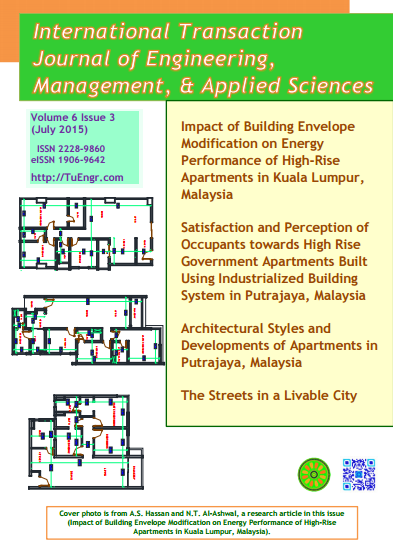- Impact of Building Envelope Modification on Energy Performance of High-Rise Apartments in Kuala Lumpur, Malaysia
 Ahmad Sanusi Hassan * and Najib Taher Al-Ashwal * (School of Housing, Building and Planning, Universiti Sains Malaysia, MALAYSIA )
Ahmad Sanusi Hassan * and Najib Taher Al-Ashwal * (School of Housing, Building and Planning, Universiti Sains Malaysia, MALAYSIA )
(Standard Version)
Keywords: Energy Saving;
thermal comfort;
passive envelope;
thermal insulation; glazing
Abstract
In residential buildings, providing comfortable living environment for building occupants is a major challenge for architects, engineers and those who involved in the building industry. It is reported that considerable energy is consumed to provide and maintain acceptable indoor conditions for thermal comfort in residential buildings in hot-humid climate. The observable increase in energy consumption is chiefly resulting from the growing use of air conditioning system. There are various energy conservation measures which can be applied to reduce energy consumption and among these measures are passive envelope design measures. This paper addresses the energy performance of selected high-rise apartments in Kuala Lumpur. Energy Plus software is utilized in measuring the performance because of its availability, validity and accuracy. Possible energy savings due to passive envelope design measures integration are investigated. This includes investigating the effect of thermal insulation and glazing type on potential energy savings.
- Satisfaction and Perception of Occupants Towards Highrise Government Apartments Built Using Industrialized Building System in Putrajaya, Malaysia
 Mazran Ismail *, Nur Haffeza Ahmad Termizi, and Ahmad Sanusi Hassan (School of Housing, Building and Planning, Universiti Sains Malaysia, MALAYSIA )
Mazran Ismail *, Nur Haffeza Ahmad Termizi, and Ahmad Sanusi Hassan (School of Housing, Building and Planning, Universiti Sains Malaysia, MALAYSIA )
(Standard Version)
Keywords: Industrialized building system;
Government quarters;
Highrise apartments;
Occupants satisfaction
Abstract
Numerous advantages have been associated with the implementation of Industrialized Building System (IBS) in Malaysia like less construction time, saving in labour, better construction quality, increasing workers safety, optimized used of material, minimizing solid waste, and construction operation less affected by weather conditions. Despite these potentials, various studies showed that the system is still not a preferred alternative to the conventional construction method due to several reasons like negative perceptions towards the system and cold reception from the industry players, while several aspects regarding people’s acceptability towards the system still remain uncertain. This study investigates the satisfaction and perception of occupants towards the multi-storey government quarters (highrise apartments) which have been built using IBS in Putrajaya, Malaysia. The main objective is to evaluate the level of occupants’ satisfaction, acceptance and expectation towards the design & construction quality of the medium cost quarters apartment, particularly in terms of size and arrangement of spaces, indoor comfort, quality of building materials and the aesthetical aspect of the overall design. For this purpose, the structured 5-point Likert scale questionnaires have been distributed and answered by 150 occupants of the 3 apartment quarters built by three different main contractors using Precast concrete walls as main IBS component. Although generally the occupants are satisfied with the overall design of their apartments and most of the internal spaces and services provided, but they expected that the quarters should be provided with better spaces of veranda & clothes drying area and the quarters should be constructed with better workmanship.
- Architectural Styles and Developments of Apartments in Putrajaya, Malaysia
 Ahmad Sanusi Hassan, Yasser Arab, and Mazran Ismail (School of Housing, Building and Planning, Universiti Sains Malaysia, MALAYSIA )
Ahmad Sanusi Hassan, Yasser Arab, and Mazran Ismail (School of Housing, Building and Planning, Universiti Sains Malaysia, MALAYSIA )
(Standard Version)
Keywords:
Traditional architecture;
Colonial;
Modern apartment
Abstract
This paper discusses development of architectural styles in Putrajaya, Malaysia which can be categorised into three styles namely traditional, colonial and modern design. Traditional architecture is an adaptation to the local climate which evolves to the condition of the place, local material, environment, native ways and culture. Colonial architecture is an adjustment of imported architecture to the local climate, a primary expression of classical style introduced by the European through colonisation and a result of cross cultural architecture with the local built environment as well as architectural styles brought by the Chinese, Arabs, Indian Muslims and Indian Hindus immigrants. Modern architecture is an adjustment of universal style to the local climate, compatible with a large number of mass-produced housing and building units since Industrial Revolution taken place in Europe. The study finds these three styles have progressed to each own identity and character in forming the architectural landscape in Putrajaya.
- The Streets in a Livable City
 Reham M. M. Mohie El-Din * (Department of Architectural Engineering and Building Technology, Faculty of Engineering, Modern Academy for Engineering and Technology, EGYPT )
Reham M. M. Mohie El-Din * (Department of Architectural Engineering and Building Technology, Faculty of Engineering, Modern Academy for Engineering and Technology, EGYPT )
(mirror)
Keywords:
Livable City Streets;
City Transportation;
Sustainable Streets;
Streets Planning.
Abstract
In a world of rapidly increasing urbanization, striving to develop more livable cities, the city’s streets designing and planning should be high on the agenda for policymakers, city planners and other practitioners, as well as researchers. Designing streets is not as easy as it might originally seem, however, done correctly it means that one third of the city was designed successfully with an immense impact on the rest of the city. The key challenge in developing sustainable and fulfilling streets is to develop an integrated approach in planning them, where it is necessary to consider all aspects involved. Meanwhile, efforts devoted to this topic vary considerably from place to place. Thus, this paper aims at discussing the main elements involved in designing streets for a livable city, in a comprehensive approach including pedestrians, vehicles, and parking areas.

 Read full issue
Read full issue

 Ahmad Sanusi Hassan * and Najib Taher Al-Ashwal * (School of Housing, Building and Planning, Universiti Sains Malaysia, MALAYSIA )
Ahmad Sanusi Hassan * and Najib Taher Al-Ashwal * (School of Housing, Building and Planning, Universiti Sains Malaysia, MALAYSIA )
 Mazran Ismail *, Nur Haffeza Ahmad Termizi, and Ahmad Sanusi Hassan (School of Housing, Building and Planning, Universiti Sains Malaysia, MALAYSIA )
Mazran Ismail *, Nur Haffeza Ahmad Termizi, and Ahmad Sanusi Hassan (School of Housing, Building and Planning, Universiti Sains Malaysia, MALAYSIA )
 Ahmad Sanusi Hassan, Yasser Arab, and Mazran Ismail (School of Housing, Building and Planning, Universiti Sains Malaysia, MALAYSIA )
Ahmad Sanusi Hassan, Yasser Arab, and Mazran Ismail (School of Housing, Building and Planning, Universiti Sains Malaysia, MALAYSIA )
 Reham M. M. Mohie El-Din * (Department of Architectural Engineering and Building Technology, Faculty of Engineering, Modern Academy for Engineering and Technology, EGYPT )
Reham M. M. Mohie El-Din * (Department of Architectural Engineering and Building Technology, Faculty of Engineering, Modern Academy for Engineering and Technology, EGYPT )